
Eschscholzia californica, the California poppy, golden poppy, California sunlight or cup of gold, is a species of flowering plant in the family Papaveraceae, native to the United States and Mexico. It is cultivated as an ornamental plant flowering in summer, with showy cup-shaped flowers in brilliant shades of red, orange and yellow. It is also used as food or a garnish. It became the official state flower of California in 1903.
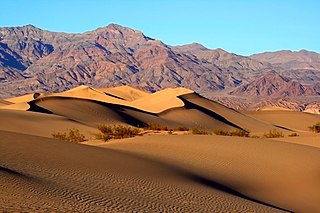
The Mojave Desert is a desert in the rain shadow of the southern Sierra Nevada mountains and Transverse Ranges in the Southwestern United States. It is named for the indigenous Mojave people. It is located primarily in southeastern California and southwestern Nevada, with small portions extending into Arizona and Utah.

The Virgin River is a tributary of the Colorado River in the U.S. states of Utah, Nevada, and Arizona. The river is about 162 miles (261 km) long. It was designated Utah's first wild and scenic river in 2009, during the centennial celebration of Zion National Park.

Juniperus californica, the California juniper, is a species of juniper native to southwestern North America.
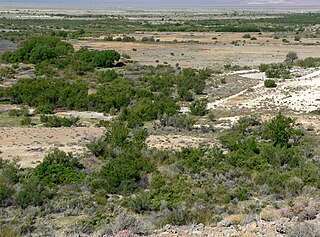
The Ash Meadows National Wildlife Refuge is a protected wildlife refuge located in the Amargosa Valley of southern Nye County, in southwestern Nevada. It is directly east of Death Valley National Park, and is 90 mi (140 km) west-northwest of Las Vegas.
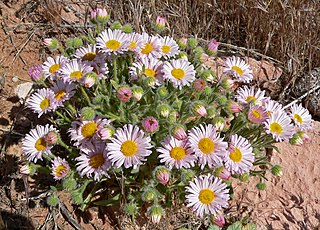
Erigeron concinnus, the Navajo fleabane, tidy fleabane or hairy daisy, is a perennial flowering plant in the family Asteraceae.

Dalea searlsiae, commonly known as Searls' prairie clover, is a perennial legume species belonging to the Dalea genus. The species is found through arid regions of the southwestern United States and can survive in low moisture conditions. The species forms symbiotic relationships with nitrogen-fixing bacteria that can improve soil nutrient levels. Its large inflorescence attracts many species of pollinators, and it lacks toxins found in similar legume species. As a result, the species has been considered for use in rangeland restoration and revegetation projects.

Arctomecon merriamii is a species of poppy known by several common names, including desert bearpoppy, white bearpoppy, and great bearclaw poppy. It is native to the Mojave Desert of California and Nevada.

Arctomecon humilis is an endangered, endemic species found only in the Dixie Corridor in southwest Utah. A. humilis grows in a very harsh desert environment, requiring a specific soil type. The plant's common name is dwarf bear-poppy, which is indicative of the plant's jagged, three “clawed” leaves. The poppy is a perennial plant, meaning it blooms annually. The dwarf bear-poppy is protected under the Endangered Species Act as of 1979. The plant is threatened by urban development, off-road vehicle use, and mining. Although hard to estimate, its population has diminished significantly over the years. There are several plans to protect the poppy, including making the land it occurs on a protected area.

Encelia actoni, also known by the common names Acton brittlebush and Acton encelia, is a species of flowering plant in the family Asteraceae.

Rafinesquia neomexicana is a species of flowering plant in the family Asteraceae. Common names include desert chicory, plumeseed, or New Mexico plumeseed. It has white showy flowers, milky sap, and weak, zigzag stems, that may grow up through other shrubs for support. It is an annual plant found in dry climate areas of the southwestern deserts of the US and northwestern deserts of Mexico.

Oenothera californica, known by the common name California evening primrose, is a species of flowering plant in the evening primrose family.
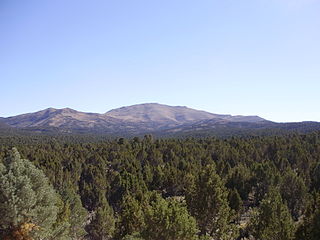
Pinyon–juniper woodland, also spelled piñon–juniper woodland, is a biome found mid-elevations in arid regions of the Western United States, characterized by being an open forest dominated by low, bushy, evergreen junipers, pinyon pines, and their associates which vary from region to region. At lower elevations, junipers often predominate and trees are spaced widely, bordering on and mingling with grassland or shrubland, but as elevation increases, pinyon pines become common and trees grow closer, forming denser canopies. Historically, pinyon-juniper woodland has provided a vital source of fuel and food for peoples of the American Southwest. These nuts have also provided a crucial source of food for species such as the Pinyon jay, which have become threatened as landowners have historically tried to convert large areas of pinyon-juniper woodland to grazing lands.
A. californica may refer to:
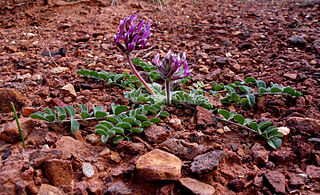
Astragalus holmgreniorum is a rare species of milkvetch known by the common names Holmgren milk-vetch and paradox milk-vetch. It is native to a tiny section of desert shrub woodland on the border between Utah and Arizona, in the far northern Mojave Desert. There are six populations remaining. It is a federally listed endangered species.
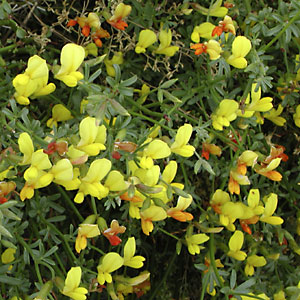
Acmispon rigidus, synonyms Lotus rigidus and Ottleya rigida, is a flowering plant in the pea family (Fabaceae), native to the southwestern United States and northwestern Mexico. It is known as shrubby deervetch or desert rock-pea. It is found in the Mojave Desert and Sonoran Desert.

Flora of the Colorado Desert, located in Southern California. The Colorado Desert is a sub-region in the Sonoran Desert ecoregion of southwestern North America. It is also known as the Low Desert, in contrast to the higher elevation Mojave Desert or High Desert, to its north.
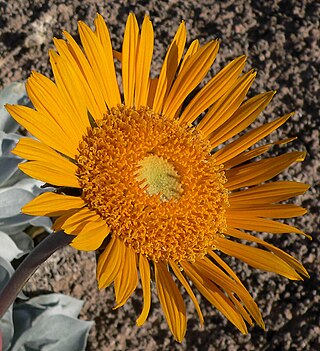
Enceliopsis argophylla, commonly known as the silverleaf sunray, is a North American species of flowering plant in the family Asteraceae. Other common names include nakedstem sunray and naked-stemmed daisy. It is native to the southwestern United States: Arizona, Nevada, and Utah, and can be seen a short distance east of Las Vegas, Nevada.
Perdita meconis, the Mojave poppy bee, is a rare bee species that was described in 1993. The Mojave poppy bee has been petitioned for protection under the Endangered Species Act due to pressures in their native range such as invasive species, habitat fragmentation, gypsum mining, and climate change.

















